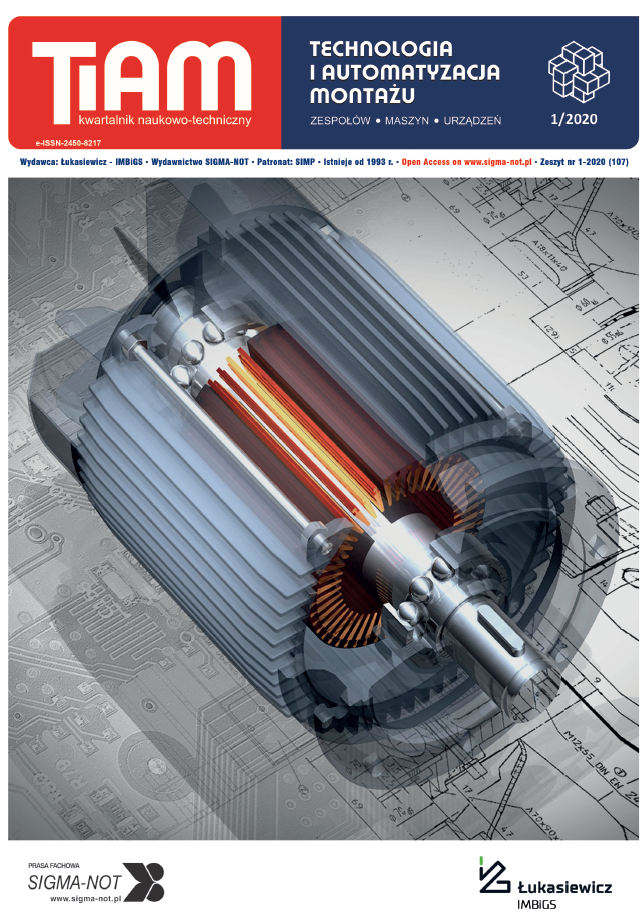Abstract
The paper presents the results of experimental studies determining the effect of temperature on the shear strength of the adhesive joint between the layers of the fiber metal laminate (FML). The tests were carried out for composites being a combination of 2024-T3 aluminum alloy sheet and Glass Fiber-Reinforced Polymer (GFRP) made in the autoclave process. The key factor determining the quality of layered composites is the high strength adhesive joint between the layers. Due to the possibility of extreme temperature conditions during utilization of the composite structure, tests were carried out at reduced temperatures, i.e. -60°C, as well as elevated temperatures, i.e. 80°C. The obtained results were related to the results obtained at a room temperature (RT). The study showed that at the elevated temperature the shear strength increased by approx. 10% compared to the result obtained at room temperature. There is also a significant reduction in the stiffness of the joint as the temperature increases. In turn, a slight increase in joint stiffness was demonstrated for the reduced temperature.
This is an Open Access article distributed under the terms of the Creative Commons Attribution License CC BY 4.0 (https://creativecommons.org/licenses/by/4.0/)
References
Adams R.D., Coppendale J., Mallick V., Al-Hamdan H. 1992. “The effect of temperature on the strength of adhesive joints”. International Journal of Adhesion and Adhesives 12:185–90.
Adams R.D., Mallick V. 1993. “The effect of tempera¬ture on the strength of adhesively-bonded composi-te-aluminium joints”. J. Adhes. 43: 17–33.
Banea M.D., da Silva L.F.M., Campilho R.D.S.G. 2014. “Effect of temperature on the shear strength of aluminium single lap bonded joints for high tem¬perature applications”. Journal of Adhesion Science and Technology 28(14-15): 1367-1381.
Banea M.D., da Silva L.F.M. 2009. “Mechanical cha¬racterization of flexible adhesives”. Journal of Adhe-sion 85:261–85.
Critchlow G.W., Brewis D.M. 1996. “Review of surfa¬ce pretreatments for aluminium alloys”. International Journal of Adhesion and Adhesives 16(4): 255–275.
Deb A., Malvade I., Biswas P., Schroeder J. 2008. “An experimental and analytical study of the mechanical behaviour of adhesively bonded joints for variable extension rates and temperatures”. International Jo¬urnal of Adhesion and Adhesives 28: 1–15.
Giannis S., Hansen K. 2010. Investigation on the Jo¬ining of CFRP-to-CFRP and CFRP-to-Aluminium for a Small Aircraft Structural Application. 25th Technical Conference of the American Society for Composites and 14th US-Japan Conference on Composite Ma¬terials.
Heidenwolf G. 2005. GLARE - Industrialization of an Advanced Light Weight Material, Airbus Deutschland GmbH A380 Programme.
Hua Y., Gu L., Trogdon M. 2012. “Three-dimensional modeling of carbon/epoxy to titanium single-lap jo¬ints with variable adhesive recess length”. Interna¬tional Journal of Adhesion and Adhesives 38: 25–30.
Ishii K., Imanaka M., Nakayama H.J. 2007. “Fatigue crack propagation behavior of adhesively-bonded CFRP/aluminum joints”. Adhes. Sci. Technol. 21: 153–167.
ISO 6892-1:2016. Metallic Materials - Tensile Testing - Part 1: Method of Test at Room Temperature. Ge-neva: International Organization for Standardization.
Kang S.G., Kim M.G., Kim C.G. 2007. “Evaluation of cryogenic performance of adhesives using composi¬te-aluminum double-lap joints”. Composite Structu¬res 78:440–6.
Khalili S.M.R., Mittal R.K., Kalibar G.S. 2005. “A stu¬dy of the mechanical properties of steel/aluminium/ grp laminates”. Materials Science and Engineering 412(1-2): 137–140.
Khoshravan M., Mehrabadi F.A. 2012. “Fracture analysis in adhesive compositematerial/aluminum joints under mode-I loading; experimental and nume¬rical approaches. International Journal of Adhesion and Adhesives 39: 8–14.
Kubit A., Trzepiecinski T., Kłonica M., Hebda M., Py¬tel M. “The influence of temperature gradient thermal shock cycles on the interlaminar shear strength of fibre metal laminate composite determined by the short beam test”. Composites Part B 176: 107217.
Narasimhan S., Shenoi R. A., Jeong, H. K. 2004. “Three-dimensional stresses in adhesively bonded lap joints with non-identical adherends”. Proceedin¬gs of the Institution of Mechanical Engineers Part L Journal of Materials Design and Applications 218(4): 283–298.
Owens J., Lee-Sullivan P. 2000. “Stiffness behavior due to fracture in adhesively bonded composite-to-a-luminum joints II”. International Journal of Adhesion and Adhesives 20: 47–58.
Pahr D.H., Rammerstorfer F.G., Rosenkranz P., Humer K., Weber H. W. 2002. “A study of short-be¬am-shear and double-lap-shear specimens of glass fabric/epoxy composites”. Composites Part B: Engi¬neering 33(2): 125-132.
Park S.Y., Choi W.J., Choi H.S., Kwon H. 2010. “Ef¬fects of surface pre-treatment and void content on GLARE laminate process characteristics”. Journal of Materials Processing Technology 210(8):1008-1016.
Ray B. C. 2005. “Thermal shock and thermal fatigue on delamination of glass fiber reinforced polymeric composites”. Journal of Reinforced Plastics and Composites 24(1): 111-16.
Schneider K., Lauke B., Beckert W. 2001. “Com¬pression shear test (CST) - a convenient appara¬tus for the estimation of apparent shear strength of composite materials”. Applied Composite Materials 8(1):43-62.
Seong M., Kim T., Nguyen K., Kweon J., Choi J. 2008. “A parametric study on the failure of bonded single-lap joints of carbon composite and aluminum”. Composite Structure 86(1-3): 135–145. Schneider K., Lauke B., Beckert W. 2001. “Compression shear test (CST) - a convenient apparatus for the estima¬tion of apparent shear strength of composite mate¬rials”. Applied Composite Materials 8(1):43-62.
da Silva L.F.M., Adams R.D. 2006. “Stress-free tem¬perature in a mixed-adhesive joint”. Journal of Adhe¬sion Science and Technology 20(15):1705-1726.
da Silva L.F.M., Adams R. 2007. „Techniques to redu¬ce the peel stresses in adhesive joints with compo¬sites”. International Journal of Adhesion and Adhesi¬ves 27: 216–226.
Sinmazcelik T., Avcu E., Ozgur Bora M., Coban O. 2003. “A review: Fibre metal laminates, background, bonding types and applied test methods”. Materials and Design 32: 3671–3685.
Srivastava V.K. 2003. “Characterization of adhesive bonded lap joints of C/C-SiC composite and Ti-6Al4V alloy under varying conditions”. International Journal of Adhesion and Adhesives 23:59–67.
Teixeira de Freitas S., Sinke J. 2014. “Adhesion Properties of Bonded Composite-to-Aluminium Jo¬ints Using Peel Tests”. The Journal of Adhesion 90(5-6): 511–525.
Trzepiecinski T., Kubit A., Kudelski R., Kwolek P, Obłój A. 2018. „ Strength properties of aluminium/ glass-fiber-reinforced laminate with additional epoxy adhesive film interlayer”. International Journal of Adhesion and Adhesives 85:29-36.


